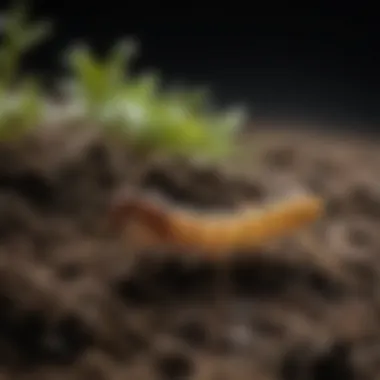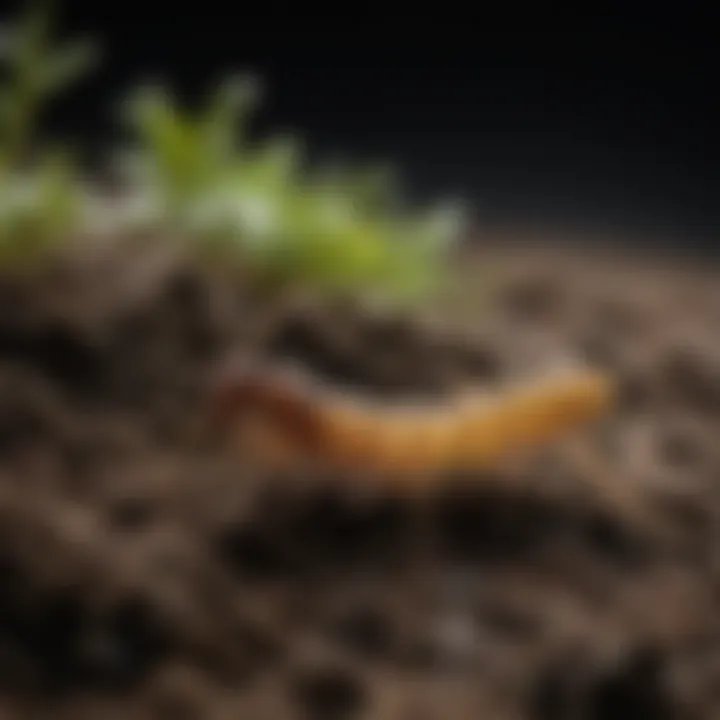Effective Strategies to Eliminate Fungus Gnats


Intro
Fungus gnats are a common concern for many houseplant enthusiasts. These tiny pests can thrive in moist, organic-rich soil, making them a prevalent issue in environments where plants are cared for with a lack of attention to soil moisture. Understanding their biology and behaviors is essential for effective management.
These dark-winged insects, usually measuring about 1/8 inch long, are often mistaken for fruit flies. Their larvae live in the soil and feed on organic matter, plant roots, and even fungal spores. They can cause significant stress to plants, ultimately leading to weakened health and growth.
Homeowners and gardening aficionados must adopt comprehensive strategies to combat fungus gnats. Their existence is not solely a nuisance; they can also be indicators of poor plant care practices, particularly overwatering. Addressing them requires an examination of both prevention and remediation techniques, creating a plan that emphasizes sustainable plant care and an understanding of pest biology.
This article will delve into effective methods for eliminating fungus gnats, covering key aspects such as cultural practices, treatment options, and insight into the life cycle of these pests. Readers will be equipped with actionable knowledge for maintaining houseplants in a healthy state, free from infestation.
Understanding Fungus Gnats
Understanding fungus gnats is crucial for anyone who manages houseplants. These pests, while small, can cause significant harm by damaging roots and contributing to poor plant health. When houseplants succumb to fungus gnat infestations, the symptoms can often be misinterpreted, leading to improper care and further plant stress. Therefore, knowing their biology, behavior, and lifecycle provides insight. This knowledge aids in the development of effective preventative and remedial strategies, helping to keep houseplants healthy.
Biology of Fungus Gnats
Fungus gnats belong to the family Sciaridae. They are characterized by their slender bodies and long legs, usually measuring about 1/16 to 1/8 inch in length. Their appearance resembles tiny fruit flies. Adult fungus gnats typically have dark, grayish wings and long, fragile antennae. They are most commonly found in damp environments, as their larvae, which are transparent with a black head, thrive in moist soil rich in organic matter.
These insects primarily feed on fungi present in the soil and may occasionally consume plant roots. This feeding behavior can lead to weakened plants and ultimately, their decline. Understanding their biological makeup is essential because it allows gardeners to choose the right control methods which target their specific vulnerabilities.
Life Cycle of Fungus Gnats
The life cycle of fungus gnats consists of four main stages: egg, larva, pupa, and adult. Females typically lay hundreds of eggs in the moist top layer of the soil, around organic matter. These eggs hatch into larvae within about four to six days.
The larval stage lasts approximately two weeks, during which the larvae actively feed. After consuming enough material, they pupate in the soil. The pupal stage lasts about three to five days before emerging as adult gnats, ready to reproduce. This rapid lifecycle of fungus gnats means infestations can build quickly if not addressed.
Behavior and Feeding Habits
Fungus gnats display specific behaviors that correlate with their feeding and reproductive patterns. Adult gnats are most active during the evening and are attracted to light sources, often congregating near windows or lamps. They are not particularly aggressive but can become a nuisance when present in large numbers. Their feeding primarily involves consuming fungi and decaying organic material in the soil. This feeding can indirectly harm houseplants by disrupting root development.
Properly managing moisture levels and soil conditions can mitigate the presence of fungus gnats. Their development is closely linked to damp soil, so understanding their behaviors helps in implementing effective strategies for their control. It is essential to recognize that while fungus gnats are a sign of other underlying issues, simply eliminating them without addressing the root cause will not be an effective long-term solution.
Identifying Fungus Gnat Infestation
Identifying a fungus gnat infestation is crucial for effective management and control of these pests. Fungus gnats can quickly become a significant nuisance for houseplants, leading to potential damage if left unchecked. Understanding how to spot these pests early helps in preventing further escalation of the problem.
By recognizing the signs early, homeowners can take preventive measures to safeguard their plants. This knowledge allows for targeted approaches to treatment, minimizing damage not only to plants but also to the overall home environment. In this section, we will explore the characteristic signs of infestation and how to distinguish fungus gnats from other similar pests.
Signs of Infestation
The presence of fungus gnats can be detected through several key signs:
- Adult Gnats: These small, dark flying insects are often seen hovering near the soil of plants or in the air around them. Their size typically ranges between 1/16 to 1/8 inch.
- Larvae: The larvae, which resemble tiny white worms, live in the upper soil layer. They can often be seen when the soil is disturbed.
- Mushy Roots: If the roots of houseplants appear mushy or decayed, it may indicate gnat presence. The larvae feed on organic matter and can damage root systems.
- Wilting Leaves: Plants that exhibit wilting leaves or stunted growth could also be affected by fungus gnats, signaling possible root damage from the larvae.
It is advisable to routinely check for these signs, especially after acquiring new plants or when changing their care routine.
Differentiating from Other Pests
Recognizing fungus gnats requires a clear understanding of their distinguishing characteristics compared to other common pests:
- Fruit Flies: Unlike fungus gnats, fruit flies are attracted to decaying organic matter and can be found around overripe fruits. They are generally larger and have a more rapid movement.
- Thrips: These pests are slender and can cause damage to leaves and flowers. Unlike fungus gnats, thrips do not thrive in moist soil environments.
- Whiteflies: Typically found on the undersides of leaves, whiteflies are easy to identify due to their white color. They also differ from fungus gnats regarding feeding habits.
By understanding these distinctions, homeowners can correctly identify fungus gnats and implement appropriate control measures swiftly, avoiding ineffective treatments targeting other pests.
Assessing the Condition of Houseplants
Assessing the condition of your houseplants is a crucial step in the ongoing battle against fungus gnats. These pests not only thrive in unhealthy environments but also contribute to the deterioration of plant health. By regularly evaluating specific elements of plant care, you can effectively reduce the chances of infestation and promote optimal growth. Understanding soil health, moisture levels, and plant stress factors allows you to make informed decisions on how to best sustain a healthy indoor garden.
Soil Health and Moisture Levels
Soil health and moisture levels are integral to plant vitality. Fungal gnats are often drawn to damp or overly wet soils, making it essential to maintain proper moisture levels. This means watering your plants only when necessary. Soil that has good drainage and does not stay soggy can greatly minimize the risk of gnat infestation.
Regularly check the texture and consistency of the soil. Healthy soil should feel crumbly, not compacted. If you find that the surface is dry, but deeper layers remain moist, you might need to adjust your watering habits. Overwatering can lead to root rot and fungus, creating a perfect breeding ground for gnats.
One method to assess soil moisture is to stick your finger into the soil about an inch deep. If it feels dry, it is time to water. Conversely, if it feels moist, hold off on watering. This simple practice can help maintain the right moisture balance.
Plant Stress Factors
Plant stress factors contribute significantly to the overall health of your plants. Stress can be caused by a variety of factors, including pests, environmental conditions, and improper care techniques. Observing these factors can aid in identifying potential risks that attract fungus gnats.
g


Common plant stress factors include:
- Inadequate light: Insufficient light can weaken plant health, making them more susceptible to pests like fungus gnats.
- Nutrient deficiencies: A lack of essential nutrients can cause plants to become weak and more inviting to infestations.
- Temperature extremes: Plants stressed by excessive heat or cold can develop health issues that may attract pests.
When you notice any signs of stress, it’s essential to take corrective action quickly. Adjusting light exposure, monitoring nutrient levels, and creating a stable temperature environment can significantly improve plant resilience.
"Healthy plants have a better chance of resisting pests, including fungus gnats. Keeping stress factors in check is vital for plant longevity."
By understanding the interconnectedness of soil health and plant stress, you better position your houseplants to thrive while reducing the risk of attracting unwanted pests.
Cultural Practices for Prevention
Cultural practices play a critical role in the long-term prevention of fungus gnat infestations in houseplants. By focusing on the fundamental aspects of plant care, homeowners can create an environment that is less hospitable to these pests. Cultural methods emphasize a holistic approach, giving consideration to soil health, moisture levels, and overall plant wellness. Adopting these practices not only mitigates the risks of infestations, but also supports the vitality and resilience of plants.
Proper Watering Techniques
Watering techniques are central to preventing fungus gnats. Excess moisture in the soil attracts these pests, creating an ideal breeding ground. To limit gnat populations, it is essential to adopt proper watering habits. Here are some key practices:
- Water when dry: Check the top layer of soil; only water when it feels dry to the touch about one to two inches down. This will help maintain healthier soil moisture levels.
- Use well-draining pots: Ensure that pots have drainage holes, which allows excess water to escape. This prevents water accumulation at the bottom and reduces the risk of gnat infestations.
- Avoid overwatering: Understand the specific watering needs of each plant. Some may need frequent watering, while others thrive with less.
Implementing these techniques can significantly decrease the allure for fungus gnats. It is often said that overwatering is the most common mistake among houseplant caretakers.
Choosing the Right Soil Mix
The choice of soil mix significantly influences the health of the plant and its susceptibility to pests. Soil that retains excessive moisture can encourage a gnat population. To avoid this, consider the following:
- Opt for a well-draining mix: A mix containing perlite or sand allows for improved drainage. This type of soil reduces moisture retention, making it less favorable for gnats.
- Select organic options: Materials like coconut coir contribute to soil aeration while also being sustainable. They help in maintaining an optimal environment for plant roots without encouraging pests.
- Avoid peat-based soils: While often used, these types retain moisture over prolonged periods, which can inadvertently attract fungus gnats.
Choosing the right mix is not just about drainage; it is also about overall plant health. Healthy plants are more resilient against pests.
Managing Humidity Levels
Humidity directly influences the lifecycle of fungus gnats. By carefully managing humidity levels, growers can deter these pests. Here are strategies to consider:
- Monitor indoor humidity: Aim for humidity levels around 40-60%. Using a hygrometer can help track moisture in the atmosphere.
- Utilize dehumidifiers: In particularly moist environments, incorporate dehumidifiers to decrease humidity. This reduces moisture buildup in the top layer of soil where gnats lay eggs.
- Ventilation: Ensure proper air circulation around the plants. Stagnant air can retain moisture, which facilitates gnat reproduction.
Managing humidity is crucial for both plant health and pest prevention. Healthy levels deter fungus gnats while promoting overall well-being in houseplants.
Adopting these cultural practices creates a solid foundation for preventing fungus gnat infestations. Healthy plants thrive in a balanced environment, which reduces reliance on chemical treatments.
In summary, cultural practices provide a sustainable framework for managing and preventing fungus gnats. By establishing proper watering techniques, choosing suitable soil mixes, and managing humidity levels, plant caretakers can foster a resilient ecosystem. This attention to detail in care might well be the most effective defense against these persistent houseplant pests.
Immediate Remedies for Infestation
Immediate remedies are essential when addressing fungus gnat infestations in houseplants. These pests can rapidly reproduce, leading to significant damage if not controlled promptly. Therefore, understanding effective treatments can save plants and maintain their health. Quick action can also help prevent more severe infestations that require extensive remediation efforts. This section covers various soil treatments and trapping methods that can address infestations directly and efficiently.
Soil Treatments
Neem Oil Application
Neem oil is derived from the seeds of the neem tree. Its application can reduce fungus gnat populations in the soil. The primary characteristic of neem oil is its ability to disrupt insect growth and reproduction. This makes it a popular choice among gardeners.
Using neem oil involves mixing it with water and applying it directly to the soil. This method targets larvae, which live in the moist soil and are most vulnerable to treatment. The unique feature of neem oil is its dual action: it not only kills larvae but also repels adult gnats. However, one must be cautious with application since overuse can be detrimental to beneficial soil organisms.
Advantages of neem oil include its organic nature and low toxicity to pets and humans. On the other hand, improper application can lead to leaf burn or harm to other plants. Overall, it remains a favored method for those seeking biological control.
Hydrogen Peroxide Solutions
Hydrogen peroxide is another effective remedy for controlling fungus gnats. This chemical can help oxygenate the soil and kill larvae upon contact. Its key characteristic is its efficiency in breaking down into water and oxygen, making it a safe option for houseplants.
To use hydrogen peroxide, dilute it with water, usually in a ratio of 1:4. Apply this solution to the soil. The unique property of hydrogen peroxide is its fast action; it can effectively eliminate larval populations quickly.
While hydrogen peroxide is beneficial, it may require repeated applications for sustained effectiveness. Overusing hydrogen peroxide can potentially lead to soil damage, depending on the concentration used. Nevertheless, it is a practical and straightforward solution for immediate relief from fungus gnat problems.
Using Traps
Traps can serve as an efficient method of directly reducing the adult gnat population. They can help catch and monitor these pests effectively.
Sticky Traps
Sticky traps are one of the most common ways to attract and capture fungus gnats. These traps are coated with a sticky substance, drawing in adult gnats who are unable to escape. A significant feature of sticky traps is their ease of use and effectiveness. They can be placed around plants and require minimal maintenance.


Monitoring the traps can help gauge the infestation level. The advantage of sticky traps is that they provide a visual representation of the gnat population, allowing for timely interventions. However, they do not address the larvae in the soil, thus should be combined with other treatments for comprehensive results.
DIY Traps
DIY traps provide an economical solution to managing fungus gnats. One popular method involves using a mixture of apple cider vinegar and dish soap. The primary characteristic of DIY traps is their simplicity and cost-effectiveness. They can be made with common household items.
To create a DIY trap, fill a bowl with apple cider vinegar and add a few drops of dish soap. Place it near infested plants, where adult gnats are more likely to land. The vinegar attracts the gnats, while the dish soap reduces surface tension, causing them to sink.
While DIY traps can be effective at capturing adult gnats, they may not provide immediate relief as quickly as commercial solutions. Nevertheless, they present a viable complementary approach for those wanting to implement a more holistic pest control strategy.
In summary, both soil treatments and trapping methods are crucial in addressing and managing fungus gnat infestations. Using a combination of these strategies can lead to more effective results, ultimately helping maintain healthy houseplants.
Biological Control Options
Biological control options represent a sustainable and ecological approach to managing fungus gnats. These methods utilize natural predators and parasites to reduce pest populations, providing a less toxic alternative to chemical treatments. The integration of biological control techniques not only targets the pests effectively but also helps in maintaining the ecological balance in your houseplant environment.
Key benefits of biological control options include:
- Eco-friendliness: These techniques minimize chemical residues, making it safer for plants, pets, and humans.
- Long-lasting effects: Beneficial organisms often continue to manage pest populations even after their initial introduction.
- Resilience: As pest populations evolve, they may develop resistance to chemical methods. Biological control utilizes natural mechanisms that pests cannot easily overcome.
However, some considerations are necessary before opting for these methods. It is essential to carefully select the right species of beneficial organisms that can thrive in your indoor environment.
Beneficial Nematodes
Beneficial nematodes are microscopic roundworms that naturally prey on fungus gnat larvae. They penetrate the larvae and release bacteria that kill them, providing an effective solution to gnat problems without harming the plants.
To utilize beneficial nematodes, select a suitable species, such as Steinernema feltiae. This nematode thrives in warm, moist soil, which aligns with the conditions favored by fungus gnats. Applications should occur during the evening or on cloudy days to reduce exposure to harsh sunlight, which can harm these nematodes. It is also important to keep soil moist after application to ensure their movement.
Moreover, keep an eye on the soil temperature. Nematodes are most effective at temperatures of around 60 to 80 degrees Fahrenheit. This biological control method requires patience, as visible results may take several weeks.
Predatory Insects
Incorporating predatory insects into your pest management strategy can be advantageous. Predatory insects such as Hypoaspis miles, a predatory mite, actively hunt and consume fungus gnat larvae in the soil.
The introduction of these insects can be done by distributing them evenly across the soil surface where gnat activity has been identified. Maintaining a slightly moist environment will provide favorable conditions for the predatory insects, allowing them to thrive and continue their task of controlling the gnat population.
Another option is the release of Aphidius colemani, which targets other pests but can help in overall pest management. Though they primarily focus on aphids, they can coexist with other beneficials, ensuring a balanced ecosystem.
In both cases, monitoring the effectiveness of these predators is crucial. Regular inspections will help assess the balance and determine if additional releases are necessary. Biological controls like these not only help in eliminating fungus gnats but also foster a healthy environment for your plants.
Chemical Control Methods
In the quest to eliminate fungus gnats from houseplants, chemical control methods can provide targeted and effective solutions. These methods should be viewed as a component of an integrated pest management strategy. While cultural practices and biological controls are essential, some infestations may require direct intervention using chemicals. This section will delve into two main types of chemical control: insecticidal soaps and systemic insecticides. Each approach has its benefits and considerations that can aid in the fight against these pests.
Insecticidal Soaps
Insecticidal soaps are an option for homeowners dealing with fungus gnats. These products are made from naturally occurring plant oils and fats that, when combined with water, create a remedy effective against insects. The primary mechanism of action is through suffocation; these soaps disrupt the cell membranes of soft-bodied pests, leading to dehydration and death.
Benefits of Insecticidal Soaps:
- Low Toxicity: Insecticidal soaps have low toxicity to humans, pets, and beneficial insects when used correctly. This makes them a safer alternative in home environments.
- Fast-Acting: These soaps typically show results within hours of application. This quick action is essential for managing an established infestation.
Considerations:
- Application Timing: It is crucial to apply these soaps directly to the insects. Ensuring thorough coverage can sometimes be challenging, especially with adults flying away.
- Moisture Sensitivity: Insecticidal soaps may degrade under certain environmental conditions, particularly hot sun or excessive moisture. Therefore, timing application when conditions are optimal can enhance effectiveness.
Systemic Insecticides
For more severe infestations, systemic insecticides can provide a robust solution. These chemicals are absorbed by the plant and move through its tissues. This means that when gnats feed on the treated plant, they consume the insecticide. This method targets not just adult gnats but also larvae in the soil.
Benefits of Systemic Insecticides:
- Long-lasting Effect: Systemic insecticides have residual activity, meaning they remain effective for an extended period. This can reduce the frequency of applications necessary to control a gnat population.
- Deep Penetration: Because these products work internally, they can uniquely target pests that are less accessible, such as larvae residing in the soil.
Considerations:
- Potential Impact on Beneficial Species: Unlike insecticidal soaps, systemic insecticides have a higher risk of affecting beneficial insects, which can disrupt the ecosystem in the potting environment.
- Careful Usage Required: Homeowners must follow application instructions closely to minimize risks associated with chemicals, including overuse or misuse.
In summary, choosing the right chemical control method will depend upon the severity of the fungus gnat infestation and the environment in which it occurs. For sensitive settings like homes, insecticidal soaps might be preferred, while systemic insecticides can serve as a potent tool against larger populations.
By integrating chemical control with other strategies, such as prevention and biological controls, homeowners can effectively manage unwanted pests and promote healthy houseplants.


Long-Term Strategies for Maintaining Healthy Plants
In the ongoing struggle against fungus gnats, sustaining a healthy environment for houseplants is critical. Long-term strategies play an important role in preventing infestations from reoccurring. Maintaining healthy plants does not only contribute to the elimination of pests but also encourages growth and resilience in your indoor garden. When plants are healthy, they become less susceptible to pests like fungus gnats, making prevention a proactive approach rather than a reactive one.
Regular Inspection and Maintenance
Regular inspection and maintenance of houseplants is vital. Homeowners should routinely check their plants and the surrounding areas for signs of pests or disease. Observing the leaves, soil, and overall plant health fosters early detection of issues, which is crucial in managing pest populations before they escalate into larger problems.
- Identify any yellowing leaves, as they can indicate stress due to overwatering or inadequate nutrients, both of which attract pests.
- Take note of any adult gnats or larvae, and respond accordingly to manage their presence.
- Cleanliness around houseplants also contributes to their wellness. Dust accumulation can block sunlight and encourage fungi, leading to an increased risk of infestation. Regularly wipe leaves and clean the area around pots.
Creating a Balanced Ecosystem
Creating a balanced ecosystem is essential for long-term plant health. This involves understanding the intricate relationships between plants, soil, and beneficial organisms. A balanced ecosystem can deter pests naturally and keep the plants thriving. Here are some key considerations:
- Companion Planting: Certain plants coexist well and can protect each other against pests. For instance, incorporating herbs like basil or marigolds may repel gnat populations and other harmful insects.
- Soil Health: Using high-quality soil with proper drainage is critical. Healthy soil can harbor beneficial microorganisms, which play a vital role in managing pest populations, including fungus gnats.
- Moisture Management: Ensure that watering practices do not create overly moist soil conditions that are hospitable for gnats. A well-draining potting mix and appropriate watering schedules can help maintain the right moisture balance.
A proactive approach with regular inspections and a balanced ecosystem will reduce the likelihood of fungus gnat infestations in houseplants.
In summary, adopting these long-term strategies not only eliminates the immediate concerns of fungus gnats but also fortifies the foundation for a sustainable indoor garden.
Evaluating Effectiveness of Control Methods
Evaluating the effectiveness of control methods is a critical component in managing fungus gnats in houseplants. When addressing an infestation, it is not enough to simply implement a solution; one must continuously assess whether the chosen strategies yield the desired results. This evaluation focuses on multiple facets of control methods that are pertinent to homeowners and gardening enthusiasts alike. Key elements of this process include monitoring plant health, assessing gnat population decline, and determining the longevity of solutions employed.
The benefits of evaluating control methods are far-reaching. First, it allows for timely adjustments to treatment plans. If a method is not working, identifying this early can save time, resources, and further stress to the plants. In addition, understanding the effectiveness of various strategies can lead to more informed decisions in future infestations. This proactive approach equips the gardener with insights that enhance overall pest management.
There are also several considerations to bear in mind when evaluating these methods:
- Diversity of Control Methods: Different practices may work better depending on the specific plant species or environmental conditions.
- Time Frame: Some methods display effectiveness quickly, while others take time. Being patient is essential.
- Integration of Methods: Often, a combination of techniques yields better results than a singular approach.
"Monitoring and adapting strategies based on effectiveness can transform pest control from reactive to proactive."
In summary, the evaluation of control methods is fundamental in the ongoing battle against fungus gnats; it empowers plant owners to create resilient ecosystems that foster healthy houseplants.
Monitoring Plant Health
Monitoring the health of houseplants is a vital practice in assessing the impact of control methods on fungus gnats. Healthy plants are less susceptible to infestations, making regular inspections critical. Checking for changes in plant appearance can signal underlying issues, be they pest-related or environmental.
Key indicators to monitor include:
- Leaf Color: Look for discoloration, which might indicate stress.
- New Growth: Healthy plants produce new leaves or stems.
- Wilting or Drooping: This can indicate general stress, often worsened by pests.
Regular health checks coupled with your control methods allows for adjustments to treatment before minor issues escalate into larger problems.
Assessing Gnat Population Decline
Assessing the decline of the gnat population directly correlates with the success of the treatments applied. A drop in their numbers suggests that the methods used are effective and should be maintained. On the other hand, stagnant or rising gnat populations signal that a change in strategy might be necessary.
To effectively assess gnat population decline, consider:
- Trap Usage: Utilizing sticky traps will provide a visual indicator of gnat numbers over time. Count and record the number of gnats caught periodically.
- Soil Observation: Examine the soil for signs of larvae or adult gnats. A reduction in larvae suggests that control methods are having a positive impact.
- Frequency of Sightings: Track how often gnats are seen flying around plants. A decrease in sightings is a promising indicator of progress.
Closure and Final Thoughts
In addressing the issue of fungus gnats in houseplants, it is essential to grasp the complexity of this problem. Not only are these pests a nuisance, but their presence can indicate underlying issues with plant care and soil health. The strategies outlined throughout this article serve as comprehensive tools for homeowners and gardening enthusiasts alike. These methods not only aim to eliminate existing infestations but also promote the longevity and vibrancy of houseplants while ensuring a harmonious indoor ecosystem.
Understanding the biology of fungus gnats is crucial. This knowledge empowers individuals to implement preventative measures effectively. For instance, adjusting watering techniques and selecting suitable soil mixes can significantly reduce the likelihood of infestations. Practical actions like regular inspection and maintenance play a pivotal role in sustaining plant health. Therefore, prevention should always be a priority rather than reactive treatment after a problem arises.
Furthermore, the article highlights the importance of integrating sustainable practices. Utilizing biological control options and being judicious with chemical treatments can help maintain not just plant health but also the surrounding environment. This balanced approach offers a holistic solution to pest management that benefits both plants and those who tend to them.
Summary of Key Strategies
- Proper Watering Techniques
- Choosing the Right Soil Mix
- Managing Humidity Levels
- Beneficial Nematodes
- Using Sticky Traps
- Water only when necessary to avoid overly moist soil.
- Use well-draining soil to limit moisture retention.
- Keep humidity at optimal levels to discourage gnats.
- Introduce predatory nematodes to combat larvae.
- Employ traps to monitor and catch adult gnats.
Importance of Prevention
Preventing fungus gnat infestations is crucial for a couple of fundamental reasons. First, it protects the overall health of houseplants, ensuring they can flourish without the stress caused by pests. Second, it minimizes the reliance on potentially harmful chemical treatments, making the home environment safer for both inhabitants and pets. Regularly checking soil conditions and adopting suitable cultural practices not only deters pests but also contributes to a more enjoyable and sustainable indoor gardening experience.
By remaining proactive, plant caregivers can create an environment that is less hospitable to pests while promoting the natural beauty of their green spaces.



